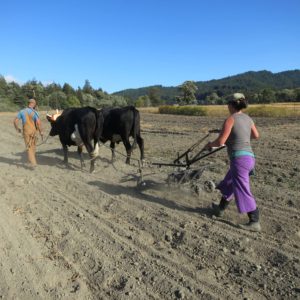Shake Fork Farm
Humboldt County, California
Can you tell me a little bit about your farm?
Melanie and Kevin have been farming at Shakefork Community Farm in Humboldt County, California, since 2009. On their 85 acre farm, they grow four acres of vegetables, about four acres of field crops and grains, and pasture sheep, cattle, and poultry. They run a vegetable CSA and have done a grain CSA in the past, but most of their grain growing at the moment is for animal feed and bedding.
How did you learn to work with oxen?
Kevin likes to say that he turned chicken into oxen. Five years ago, with an interest in draft power, he traded four of his chickens for four Holstein-Jersey bull calves. He had no experience working with draft animals, and figured that oxen would be an inexpensive, low-risk way to see if draft power could work on his farm. Two of those original oxen are the farm’s main team, Tex and Joe. Primary tillage is done with a tractor, and the oxen handle the bed shaping, potato hilling, and cultivation with an Annie’s-all-in-one in the vegetable garden. The team has done lots of work pulling salvaged lumber that drifts onto the farm down the Van Duzen River, as well as general hauling around the farm. Kevin is planning on getting the oxen set up with discing and harrowing in the future, and plans to add the capacity to rake hay with oxen this coming season. Kevin is a totally self-taught teamster. Oxen he says, felt like a more reasonable choice for his farm than horses, considering the relatively lower start-up costs and the DIY nature of oxen equipment. The closest farm that he knows of that uses draft horses is a 3 hour drive, and there isn’t the same kind of network of suppliers of draft animal equipment as there is in the northeast. Kevin orders his bows from Massachusetts, and has carved all of his yokes himself. He has also gotten into forging hardware with a local blacksmith.
Though he believes that oxen are more forgiving for beginners teaching themselves, some of the hardest lessons he has learned come from not having any in-the-flesh mentors. “The hardest thing,” he says, “has been to try to understand what an animal is capable of. Probably some of the greatest mistakes I’ve made have been to push them too hard too fast. I’ve adjusted my expectations of what is possible, and what is reasonable for a given task.”
What is the future for draft power on your farm?
“With oxen,” Kevin says, “it really makes a lot more sense to train your own.” To that end, Kevin in continuing to train oxen, and is currently working with a younger team of shorthorns. Kevin hopes that with more animals, he will be able to do more of the farm’s tillage with draft power. Additionally, Kevin has seen that some apprentices are attracted to the farm because of the opportunity to work with oxen. He hopes to develop his skills, both in training animals and in training teamsters. “I have a lot to learn about teaching other people how to drive,” he says.
On DAPNET
As a self-taught teamster, the DAPNet forums have been an important place to learn and to share experiences. “DAPNet has been such a big part of my journey,” Kevin says, “because I haven’t had any in the flesh mentors.” Last September, Kevin was able to fly across the country to attend the Draft Animal Power Field Days in Cummington, Massachusetts, a very important event in his learning process. “Until then,” he says, “I had never seen another live team of oxen, other than my own. It was a great experience to work with other teams and meet other teamsters.” That experience affirmed for him the power of teaching himself. “I realized I’m doing pretty good,” he says. “I’ve learned a lot from my mistakes.”
